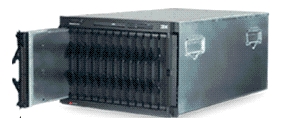B
S N
C
BSNC (Blade Server Network Cloning)
is mainly developed for Linux system administrators for those companies
that bought IBM
eServer BladeCenter, in most cases, the BladeCenter will be
hosted in data center and might be running LVS (Linux Virtual Server)
for high availability purpose. For example, use it as web farm. So, you
may need to clone one pre-prepared blade web server to the rest of the
blades, with BSNC, and the management module that comes with IBM BladeCenter , you can cloning back pre-prepared disk image remotely without going to data center.
BSNC (Blade Server Network Cloning)
is based on RIP
(Recovery is Possible) version 5.6 and PXE . Basically, I made some
changes for RIP 5.6 startup files and added some additional libraries
and programs to make automatic RSH possible. As for PXE, I
already included into BSNC, so you don't have to
install PXE again.
How It Works
Firstly, you need to prepare an compressed Linux 'dd'
server disk image of a working blade web server A, put this image file
to blade server B which is blade disk image server(also can be another server on the local LAN);
After that, you can login to blade management module through browser to change BIOS boot sequence
of server C to boot from PXE first
which means you will be booting blade server C from disk image server B on the local LAN.
Because the server B will be acting as a DHCP/TFTP/RSH
server, during the bootup, server C will get kernel and related startup
files from server B to boot up a Linux OS, then OS will clone back the
latest
blade web server disk image from server B to the hard disk of
blade server C
automatically.
Finally, blade server C will reboot automatically and will be exactly same as web server A.
Explaination
Let's take a look at IBM eServer BladeCenter first:

It can hold up to 14 blades, each blade has two network interfaces
eth0(external) and eth1(internal) which are connected to backend integrated
switches. Let's choose one of blade as Linux disk image server
named 'image' (ipaddr: 192.168.10.1), this disk image server can also
be
another seperated server on the internal LAN, it doesn't have to be
blade server, as long as it has enough hard disk space to hold blade
server disk image files, this disk image server also must be a DHCP/TFTP
server because we may need to clone many blades at the same time, so
there won't be IP address conflict.
Preparation
You need to prepare the following things before using BSNC to do
networking cloning remotely.
- A working original blade server A which need to be cloned to the
rest of the blades, I resume it runs Linux.
- Disk image server B is properly configured as a DHCP,TFTP and RSH
server. (let's use IP address 192.168.10.1 for internal NIC)
- On the server A, prepare blade disk image with the command # dd if=/dev/hda | gzip
-c | rsh 192.168.10.1 'dd of=/data/diskimage/blade.ddimg' , server A must be able to rsh into
server B without any prompt, this command will generate a compressed
blade hard disk image file and store in server B.
click here to learn how to make blade.ddimg smaller?
- RSH server need to allow the whole DHCP range IP address so that
any blade can rsh into disk image server as root without prompt.
Download
Download the latest BSNC Network/CDROM release from sourceforge
file list page.
You can read this README before using bsnc-cdrom package.
Also, you can download DHCP,TFTP and RSH server configuration
examples.
How to Use
1. make sure blade image server B is configured as DHCP/RSH/TFTP
server too, you can refer to the above configuration example.
2. make sure the original blade server dd image is generated and
filed as /data/diskimage/blade.ddimg on image server, you can download the image generation
scripts here.
3. download BSNC from sourceforge
file list page,
4. extract BSNC tarball under /tftpboot ( # cd /tftpboot; tar
xvfpz bsnc.tar.gz )
5. open browser, type in the ip address of BladeCenter management
module, change blade server A BIOS boot sequence to PXE first.
6. supposely, blade server A will get kernel from image server B
through DHCP/TFTP, then use RSH to write blade dd image file to the
local IDE hard disk, this will be done automatically, after that, it
will reboot by itself and a new web server or whatever will be up.
My other project -
EWMS - Enterprise WebMail Solution
My Blog - linuxtechres.blogspot.com - Linux/BSD sysadmin and Oracle/DB2 DBA guide
